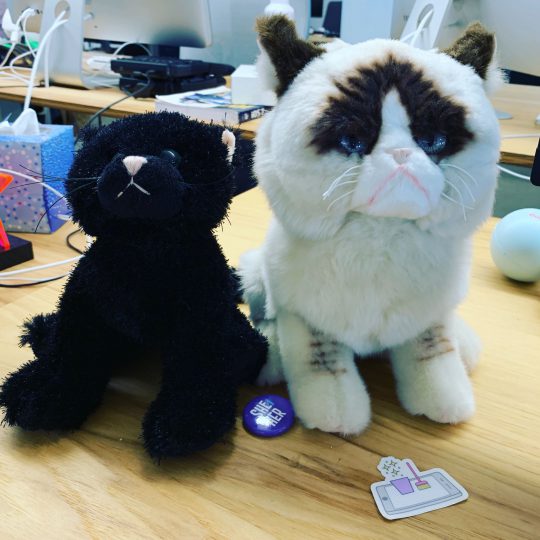
Some sad news today in the world of cats and synths. Oscar, the cat whose photo sitting inside a Moog modular went viral and delighted so many, has passed away. We at CatSynth extend our deepest condolences to Oscar’s family.

We say goodbye to another musical hero. Manu Dibango passed away today at his home in France, apparently of complications from Covid-19.

Like many others, I knew Dibango’s music initially through the song “Soul Makossa.” I had heard it on and off over the years, but it was after delving more seriously into the history of 1970s disco in 2010 that I rediscovered the song and its connection to the early disco gatherings of New York including David Mancuso’s Loft parties. It was a B-side of a single that Mancuso found and it became an instant proto-disco hit, and on regular rotation in my own playlist in the early 2010s. It also went on to be a major influence on R&B and funk. It was instantly recognizable with the chat “Soul Makossa”, Dibango’s growling saxophone and catchy horn hook.
Dibango was originally from Cameroon – indeed makossa is a traditional style of Cameroonian music and came up in central Africa’s jazz scene, including African Jazz in Kinshasa, Congo. Over the years he has collaborated with other heroes of ours including Fela Kuti and Herbie Hancock, with whom he recorded the album Electric Africa in the 1980s.
It is jarring to hear of Dibango’s death being so connected to the current crisis, and certainly not the last. His music represents, at least for me, simpler and brighter times, the optimism and nostalgia of the 1970s, and more. RIP.
The second of our remembrances focuses on the architect I.M. Pei, who passed away this week. A true champion of modernism worldwide, I have admired his work both from afar and close up.
Perhaps the most vivid memory with his work was from the Suzhou Museum in Suzhou, China. It may not be his best known work, but it is a masterpiece in itself and a love letter to his hometown.

The exterior facade combines Pei’s trademark geometry and minimalism with more the more traditional designs and tropes of an adjacent palace and Suzhou’s famous gardens. It also makes extensive use of water as an architectural element both inside and outside the building.


The simple geometric shapes, as well as the use of water, stone, and glass, gave the entire complex a very warm and welcoming feeling, even as the rain came down around me. Inside, the simplicity of the galleries left ample mental space to enjoy the exhibits and artifacts, while the atrium was a work of art itself.
I admire the way he often brought modernist aesthetics and principles to traditional spaces. This is perhaps most dramatically seen in his glass pyramid that anchors the Louvre Museum in Paris.

The pyramid is perfect, a stark contrast to the severe facades around it, and perfectly balanced in size and space. While I know many traditionalists have hated on this addition over the years, I for one love it. I am an unapologetic modernist and often find myself sparring with traditionalists even here in San Francisco.
Pei’s modernism was intended to integrate with its surroundings, even as it stood in contrast to it. For example, he wanted his stark geometric design for the Mesa Laboratory at the National Center for Atmospheric Research (U.S.A.) to look “as if it were carved out of the mountain”.

Until reading others’ tributes and remembrances, I had forgotten about his role in the Javits Center in New York, a building I am quite familiar with both inside and out. It is a massive and imposing structure but crisscrossed with triangular details that remind me of the Suzhou Museum (built 20 years later). The project was plagued by challenges and controversies, and “during the inauguration ceremonies, however, neither [James] Freed nor Pei was recognized for their role in the project.” [source]

Triangles do seem to be a major recurring theme in his work, and perhaps part of why it appeals to me even within the scope of other modernists. Triangles are powerful and strong, and the often stand out in Western spaces dominated by rectangles. These elements also played a role East Building for the National Gallery in Washington, D.C., a project is loved by many, but similar to the Louvre, criticized by some traditionalists.
The building is a masterpiece of minimalism. Even some of those traditionalist critics have grown to love it in the years since it opened in 1978. And it serves its purpose, both as a home to art and a work of art itself.
The growing popularity of art museums presented unique challenges to the architecture. Mellon and Pei both expected large crowds of people to visit the new building, and they planned accordingly. To this end, he designed a large lobby roofed with enormous skylights. Individual galleries are located along the periphery, allowing visitors to return after viewing each exhibit to the spacious main room. A large mobile sculpture by American artist Alexander Calder was later added to the lobby.[93] Pei hoped the lobby would be exciting to the public in the same way as the central room of the Guggenheim Museum in New York. The modern museum, he said later, “must pay greater attention to its educational responsibility, especially to the young.”[94]
https://en.wikipedia.org/wiki/I._M._Pei#National_Gallery_East_Building,_Washington,_DC
Defending modernism, even after a century, remains a tireless job. As we lose champions like I.M. Pei, it falls to those of us in later generations to make sure this beauty is preserved and celebrated.
In the past 24 hours, we have heard about the passing of two of our heroes, who hailed from different walks of life and even different species. In the first of our two remembrances, we bid farewell to the beloved Tardar Sauce, aka “Grumpy Cat”, has passed away. This was posted on Grumpy Cat’s official Facebook page this morning.

Despite care from top professionals, as well as from her very loving family, Grumpy encountered complications from a recent urinary tract infection and unfortunately become too tough for her to overcome. She passed away peacefully on the morning of Tuesday, May 14, at home in the arms of her mommy, Tabatha.
Besides being our baby and a cherished member of the family, Grumpy Cat has helped millions of people smile all around the world, even when times were tough.
https://twitter.com/RealGrumpyCat/status/1129310647458467840
Tardar Sauce’s feline dwarfism gave her face a sunken appearance, that together with her markings always made her look “grumpy” and launched a great many instantly usable internet memes. Even former President Barack Obama channeled Grumpy Cat on at least one occasion.
In reality, she seemed like a very sweet and docile cat, at least in the television appearances that we saw. She became quite the celebrity and her face graced many publications and toys, including this stuffed version of Grumpy Cat that has now sat on my desk at home and three different workplaces.

It’s always sad when a family says goodbye to a beloved feline companion – it’s a pain I know well. We wish Grumpy’s human and feline family our thoughts and sincerest condolences for their loss, and will do our part to keep her memory alive.
https://www.youtube.com/watch?v=KB5sMYw37gw
We pay tribute to the late Aretha Franklin with one of my favorite tracks, “Rock Steady” from the album Young, Gifted and Black. It is the perfect coming together of soul and funk. Regular readers know that even as I am immersed in all things synthesizer and electronic, soul, funk, jazz fusion are close to my musical heart.
RIP, Queen of Soul 😿
We learned yesterday of the passing of another of our musical heroes, Cecil Taylor.
This segment of solo piano demonstrates how his playing is incredibly complex but remains thoroughly musical. The fast runs contain a unique contrapuntal language. And more importantly, there is phrasing, contour, and emotion that unifies the performance. Taylor had an uncanny ability to combine European classical tradition, jazz, and other African American influences into a unique musical language that he dubbed “black methodology”. This quote from poet and critic A. B. Spellman, included in the official New York Times obituary, sums it up well.
“There is only one musician who has, by general agreement even among those who have disliked his music, been able to incorporate all that he wants to take from classical and modern Western composition into his own distinctly individual kind of blues without in the least compromising those blues, and that is Cecil Taylor, a kind of Bartok in reverse.”
It is hard for me not to compare Taylor with another contemporary of his, Ornette Coleman, who passed away in 2015. Coleman is one of my favorites – Taylor takes the level of complexity to another level. Both remain huge influences. We leave you with this recording of “Calling It the 9th”.
This is such heartbreaking news. Bento, the Keyboard Cat has passed away 😿
His humans made this wonderful tribute to Bento and his legacy, including many classic clips; and a sweet story about how he was a source of inspiration for his human companion, Charlie Schmidt.
Bento was actually the second Keyboard Cat. The original, Fatso, also lived with Schmidt but passed away in 1987, long before the age of internet memes. You can read more about the story of Fatso, Bento, and Schmidt at the Keyboard Cat Wikipedia page. Like my cats, Bento was a shelter cat and became a public face for the Shelter Pet Project. We saw him featured in billboards and bus stops here in San Francisco.
Keyboard Cat has always been a favorite of mine – how could it not, given the combination of interests. We always had fun with the early “play him/her off” videos, and it became a frequent tag-line of mine to say “You have been played off by the Keyboard Cat”, especially when someone loses a political election. I wish we had been able to cross paths in person.
We at CatSynth extend our sympathies to Charlie Schmidt and the rest of Bento’s family. Rest in peace, Keyboard Cat, you have been played off. 💕
On the news of Walter Becker’s passing, we post this classic live performance of Steely Dan.
Steely Dan seems to be one of those bands that elicit strong emotions, people seem to love them or love to hate them. While I had a soft spot for a long time that I had to occasionally defend, there had faded into the background until Aja became part of the rotation of albums I listened to during my recovery last summer. This was a deeper listening beneath the slick production to hear the chord progressions and the dark but clever lyrics. And as I write more lyrics in my music, I hear the influence of their words.
I do get the sense that the polarizing reaction to Steely Dan does tend to cleave along similar lines to other musical divisions of the 1970s, most notoriously the anti-disco crusaders from the hard rock world. But that is a story for another time…
I have a sudden urge to play the saxophone, drink scotch whiskey all night long, but preferably not die behind the wheel. 🎷🥃
— CatSynth / amanda c (@catsynth) September 3, 2017
This year our friends at Moog Music, Inc. had a very different sort of booth. Instead of the usual array of gear for demonstration, the space was bare and stark, with a simple kiosk and a wall dedicated to the many synthesizer players and innovators we lost in 2016.

It was a rough year for the synthesizer community. Among those we lost were Pauline Oliveros and Don Buchla, both of whom were memorialized here on CatSynth and whom I had known in person. There were also images and statements for Keith Emerson, Bernie Worrell, Isao Tomita, and Jean-Jaques Perrey.


Visitors were invited to wander the space in contemplation or with a mix of music from the artists on classic Walkmans. Visitors could also leave social media tributes to one or more artists and have an opportunity to win one of several current Moog instruments, including a Werkstatt, Mother-32 and even a new Model D.

We didn’t win, but were very touched by the way Moog used their space to pay tribute to the many heroes we lost in 2016. It was a unique and moving experience at this year’s NAMM show.

 2015 may have been a difficult year, but 2016 was a true annus horribilis. It was a year of loss. The graphic only represents a subset that we elegized in 2016 here on CatSynth. Some were personal, some were heroes, some symbolic. There were many deaths. A dark illiberal populist pall has been cast over the country and the world. But most of all, I am still grieving for the loss of our beloved Luna.
2015 may have been a difficult year, but 2016 was a true annus horribilis. It was a year of loss. The graphic only represents a subset that we elegized in 2016 here on CatSynth. Some were personal, some were heroes, some symbolic. There were many deaths. A dark illiberal populist pall has been cast over the country and the world. But most of all, I am still grieving for the loss of our beloved Luna.
How does one keep going after a year like this? The answer I give to friends who have asked that question in the past is that we have no choice. Surviving is what we do, until that day when we don’t.
To be fair, there were many good things this year. Much good music and art that we have written about; career and personal life are much better now than they were a year ago as well. And we look forward to many adventures with our new cat Sam Sam in the coming years.
It’s hard to know what will come to in 2017. It’s a prime number, which brings us a modicum of joy. A see quite a bit of anxiety ahead, but also things to look forward to, including in January. We shall see…